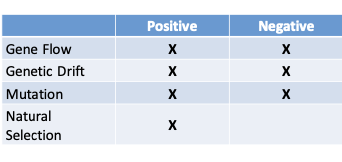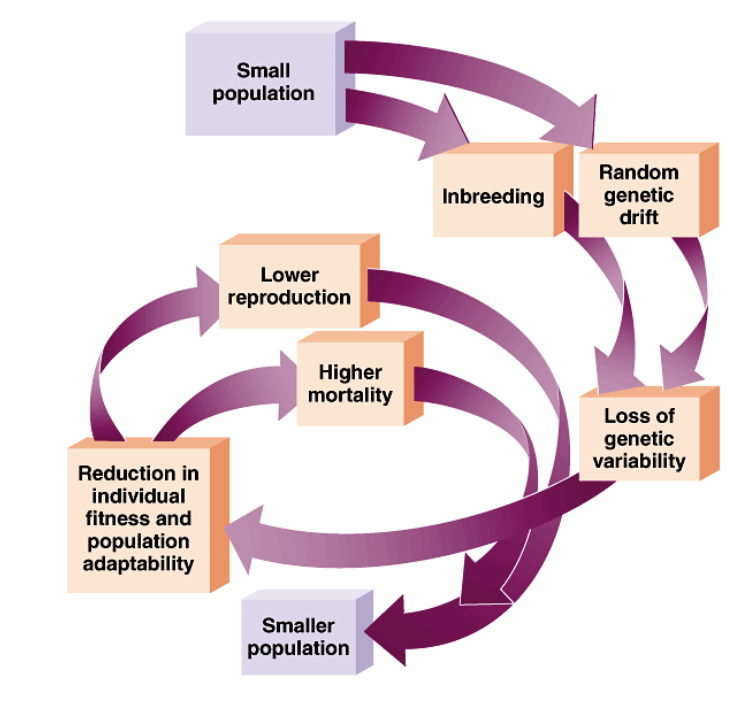UCM Ecology Exam 2
1/168
Earn XP
Description and Tags
Chapters 4-7
Name | Mastery | Learn | Test | Matching | Spaced |
|---|
No study sessions yet.
169 Terms
centerpiece of ecology
theory of evolution by natural selection
evolution
change over time in the allele frequencies in a population
adaptation
characteristics that improves an organisms ability to survive or reproduce
chromosomes
tightly coiled DNA
gene
DNA segments that code for proteins / traits
alleles
different forms of a gene
EX] AA, aa, Aa
natural selection
process in which individuals with certain characteristics tend to survive and reproduce at a higher rate
acts on an organism’s phenotype
lamarck
transformism
“inheritance of acquired characteristics”
transformism
complex organisms have developed gradually over geologic time from simpler ones
individuals passed on changes acquired during their lifetimes
EX] giraffe long necks, the more they stretch to reach leaves the longer their necks get, then pass the long necks onto offspring
malthus
“an essay on the principle of population”
human pop was growing very fast but the food supply was not, he asked what would happen and when
essay inspired Darwin’s thoughts on competition for resources and what advantages would help people survive and reproduce
hutton
theory of uniformitarianism = geological processes are slow
EX] erosion, sedimentation
+ Lyell
Darwin
evolution by natural selection
descent with modification in “the origin of species”
wallace
“father of biogeography”
theory of evolution through natural selection (Darwin had more evidence)
mendel
“father of modern genetics”
darwin’s observations
The distinction between species and varieties of species were sometimes unclear
Fossil animals are now extinct but similar to living species
Geographic variation and species replacement
Gradients of change in species among islands, but also within islands
breeders can select desirable characters
natural selection summary
offspring appear, behave, and function like their parents
cartoon exists and is heritable
more offspring are produced than the environment can support
some individuals have a higher chance of surviving and therefore reproducing
ALL due to their traits
descent with modification
populations accumulate differences over time
eventually can lead to macroevolution
macroevolution
results in new species
differ from ancestors (modification)
share characteristics with ancestors (descent)
age of earth
4.55 billion years
mechanisms of evolution
natural selection
mutations
gene flow
genetic drift
fitness
genetic contribution of an organism of future generations
types of natural selection
stabilizing selection
directional selection
disruptive selection
artificial selection
stabilizing selection
intermediate phenotypic trait is favored over the extremes
EX] middle sized owls
directional selection
favors one extreme
EX] cheetah/gazelle speed
disruptive selection
two extreme phenotypes are favored over the intermediate trait
EX] bird beak size
artificial selection
natural selection by humans
EX] selective harvesting (hunting bigger animals), antibiotic resistance
mutations
different alleles are formed by mutations, can provide new genes
ultimate source of genetic variation
central to evolutionary process
recombination rearranges existing variation
rare events
gene flow
movements of alleles (dispersal)
makes populations more similar to each other
can introduce new alleles into a population
genetic drift
chance events (random)
most influential in small populations / short times
fixation
allele reaches 100% frequency (not necessarily uncommon)
impacts of genetic drift
allele frequencies fixation (or lost)
reduces genetic variation in population
can increase frequency of bad alleles
increase differences between populations
founder effect
few individuals start a new, isolated population
their alleles will become a significant fraction
genetic drift example
bottleneck effect
population is drastically reduced in size
the surviving individuals constitute a random genetic sample of the original population
genetic drift example
all four types of adaptations can have a negative and positive effect except for….
natural selection

harmful effects of low genetic diversity
random loss of genetic variation
inbreeding (mating between close relatives)
allele effects in small populations
population growth rate decreases as the population density decreases
individual fitness lower at low population sizes
loss of genetic diversity = lower reproductive success
difficulty finding mates
extinction vortex
positive feedback system
small populations tend to get even smaller

phenotypic variation is due to …
genes AND environment
examples of environmental effects on phenotypes
temp can determine turtle sex
pH can determine flower color
season can determine rabbits coat color
phenotypic plasticity
variation in form due to the environment
ecotypes
locally adapted and genetically distinctive populations
evolutionary significant unit
populations that exhibit a high level of genetic differentiation may need to be managed as separate units
sexual selection
organisms ability to obtain or successfully copulate with a mate (males and females may differ in morphology and behavior)
characters that help organs obtain mates
little value/could be disadvantageous
morphology differences
sexual dimorphism
size
color
structures
behavior (territorial, secretive, etc)
intersexual selection
usually female choosing male (mate choice)
intersexual selection
male-male competition (aggressive behaviors)
why the differences in male-female mating strategies?
females usually have greater investment in reproduction = choosy
males usually have a higher reproductive potential = aggressive, competitive
more mates = higher level of aggression
variation in reproductive success greater for males than females
runaway theory
if females prefer a trait that trait and preference is passed on
handicap principle
traits displayed by males in good condition ONLY = honest indicators of male condition
evolutionary arms race
a change in the traits of one species act as a selection pressure on the other species
drives directional selection
the red queen hypothesis
“now here you see it takes all the running you can do to keep in the same place)
coevolution
reciprocity
species A evolves because of species B and species B evolves because of species A
biological species concept
individual can interbreed (exchange alleles)
produce fertile offspring
hybrids are not their own species because they are sterile
reproductively isolated
how do we classify asexual reproducing organisms
morphology
ecology
DNA (chemical)
scientific names
binomial name - Latin - italicized
1st word = genus
capitalized
2nd word = species
never capitalized
EX] Puma concolor
taxonomy
classifying and naming organisms
taxon / taxa
systematics
evolutionary relationships of organisms
degree of divergence
cladistics
Developing phylogenetic trees/cladograms
Uses ancestral and derived characters (not similarities)
Timing
Taxonomic Hierarchy
domain
kingdom
phylum
class
order
family
genus
species
phylogenies
branching
length of branches
homologous structures
similarities due to shared ancestry
analogous structures
similar structures on unrelated species
convergent evolution
adaptations to deal with a common environment
macroevolution
fossil record is rich with transitional forms
small changes accumulate
how do species form
allopatric speciation
symmetric speciaiton
allopatric speciation
populations become isolated (geographic speciation)
sympatric speciation
inhabit same geographic region but become two different species
isolating mechanisms of reproduction
prezygotic
postzygotic
interbreeding in populations
if populations DO interbreed, they cannot diverge
if populations DO NOT interbreed, each can develop different adaptations
preventing mixing of genes = critical part of formation of new species
prezygotic mechanisms
geographical isolation
EX] located in different places
ecological isolation
EX] different habitats but can be in the same location
temporal isolation
EX] different breeding seasons
behavioral isolation
EX] courtship differences (songs, dances, gifts)
mechanical isolation
EX] ?
prevention of gamete fusion
incomplete reproductive isolation
ongoing hybridization
fuzzy species boundaries
possible outcomes of hybridization
fusion
become one species
continue hybridization
stable zone
reinforcement
very different species
species concept
several species that are difficult to separate
subspecies
consistent geographic variation
evolutionary significant units (ESU)
looking at genetic difference in populations than can be significant for present and future generations
could be an entire species
a species may have several ESUs
temperature with evolution
ecologically important environmental factor
organisms have evolved to regulate body temperature
microclimate
scale of a few kilometers, meters or cm
space matters, scale related to organism
macroclimate
large scale - climate diagrams
microclimate factos
altitude
aspect
color of ground
vegetation
boulders/burrows
aquatic temperatures
microclimate altitude
temp higher at lower elevations
microclimate aspect
northern aspect in shade (cooler, wetter)
VS
southern aspect in sun (warmer, drier)
moss on the north side of a tree
cooler, more moisture
microclimate color of ground
albedo
light surfaces reflect sun (high albedo) vice versa
arid and semiarid areas = more bare ground due to absorption vs reflection
microclimate vegetation
plants provide shade
microclimate boulders and burrows
soil is a good insulator, under soil is more cooler and humid
microclimate aquatic temperatures
resistant to change because of its specific heat (capacity to absorb heat), water stabilizes temperature
3000 times higher than air
ectotherms
external sources of energy
endotherms
internal sources of energy
thermal neutral zone
range of temps when metabcoil rate does not change
lower than thermal neutral zone
increase metabolic rate, metabolize energy stores, shiver
higher than thermal neutral zone
increased heart rate, increased blood flow to skin, sweat
why is regulating body temperature so important?
rates of chemical reactions are very specific
evolutionary tradeoffs
no species can thrive under all conditions due to energy limitations
principle of allocation
as a population adapts to a set of conditions, its fitness under other conditions is reduced (evolutionary tradeoffs)
adaptation vs acclimation
adaptation = long-term, genetic response of a population
acclimation = short-term, a type of adaptation
BOTh reduce/minimize stress, both require tradeoffs
psychrophilic
cold loving
high altitudes, deep water
thermophilic
heat loving
hot springs, temps up to 110C
heat budget
Hs = Hm +- Hcd +- Hcv +- Hr = He

metabolic heat
always a heat gain
conduction
direct physical contact
heat flow from warmer object to colder object